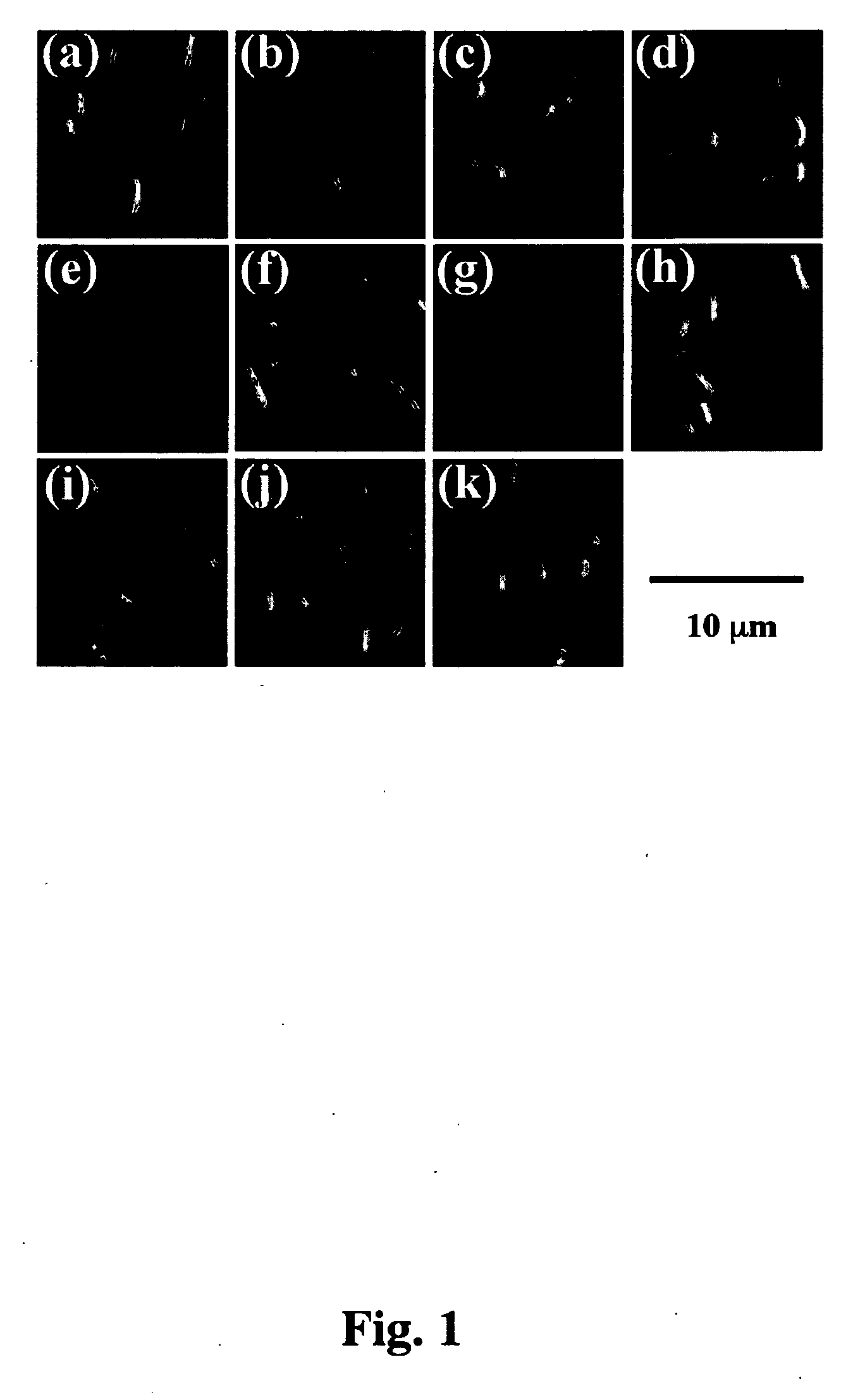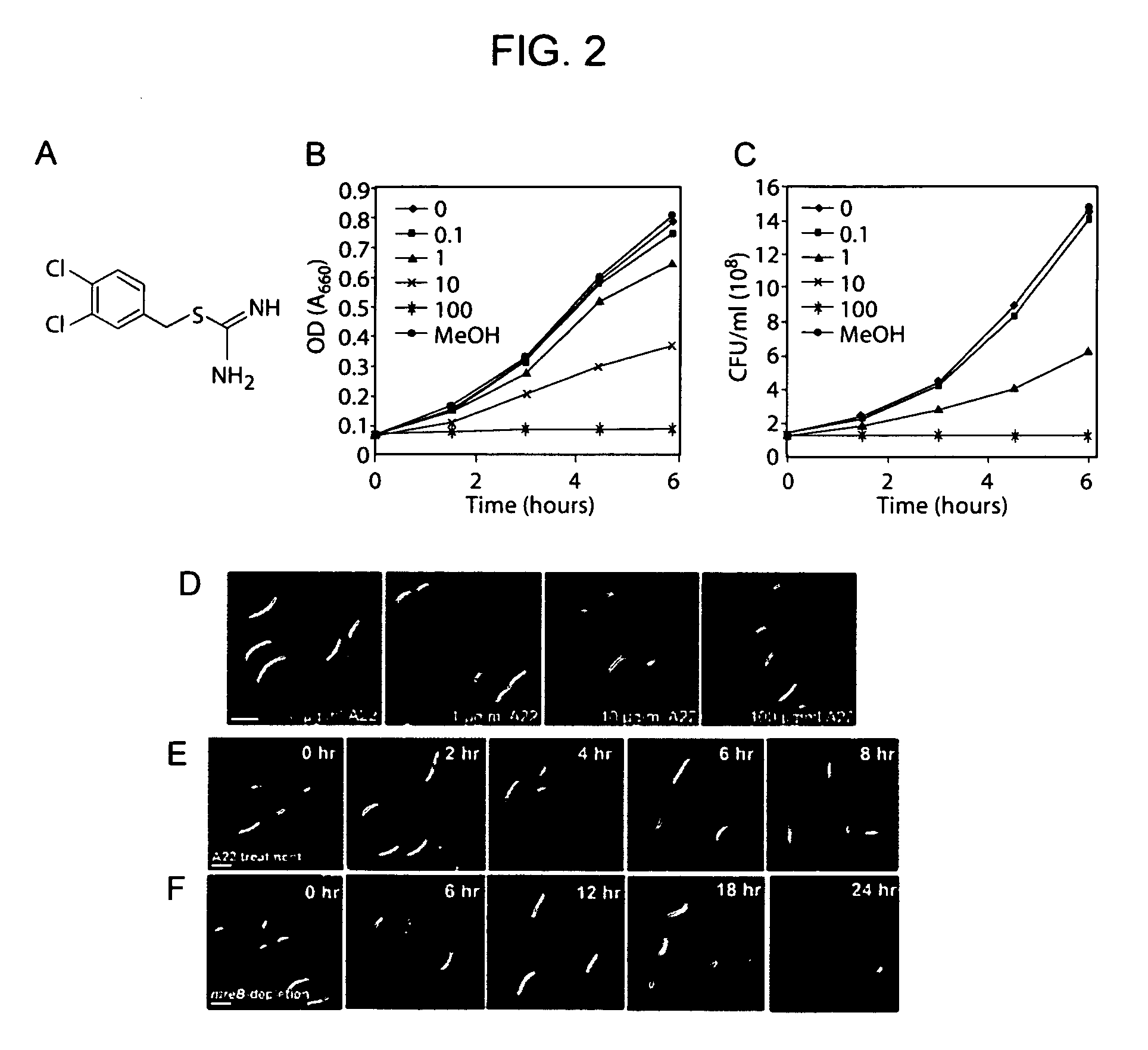Antibiotics targeting MreB
a technology of antibiotics and bacteria, applied in the field of antibiotics targeting mreb, can solve the problems of inability to detect and treat multi-drug-resistant pathogens, lack of experimental validation, and inability to identify the molecular mechanism by which bacteria execute the segregation process
- Summary
- Abstract
- Description
- Claims
- Application Information
AI Technical Summary
Benefits of technology
Problems solved by technology
Method used
Image
Examples
example 1
Structure-Activity Relationship of S-Benzylisothiourea Derivatives to Induce Spherical Cells in Escherichia coli
[0101] A22 induces spherical cells and spherical anucleate cells in E. coli. The spherical cells induced by the treatment with A22 varied in size, and anucleate cells seemed to be more frequent among the smaller cells. These results suggest that loss of the rod shape in E. coli led to asymmetric cell division that resulted in the production of anucleate cells. The β-lactam antibiotic, mecillinam, is also known to induce spherical cells by inhibiting the penicillin-binding protein (PBP) 2 that is involved in side-wall peptidoglycan synthesis. However, an in vitro assay of 14C-penicillin G binding has suggested that the target molecule of A22 was not PBP 2. A22 may act on a rod-shape-determining protein(s) other than PBP 2 such as RodA or MreB. Thus, A22 is expected to be a novel bioprobe for analyzing the shape-determination mechanism of E. coli as well as to be a lead com...
example 2
[0120] The MIC of each compound listed below was tested for E. coli, Pseudomonas putida, Salmonella typhimurium, Bacillus subtilis, and Staphylococcus aureus, using the methods as described in Example 1.
MIC (μg / ml)CompoundsE. coliP. putidamuriumB. subtilisS. aureusShape4-ClHCl3.13>1003.13>100>100Sphere3-ClHCl50>100>10050>100Sphere2-ClHCl12.5>10025>100>100Sphere4-FHCl12.5>10012.550100Sphere3-FHCl50>100>10050>100Sphere2-FHCl25>10025>100>100Sphere4-CF3HCl50>100>100>100>100Sphere3-CF3HCl>100>100>100>100>100Sphere2-CF3HCl>100>100>100>100>100Sphere4-CH3HCl25>10050>100>100Sphere4-BrHBr3.13>1006.25>100>100Sphere4-IHCl12.5>10025>100>100Sphere4-NO2HCl25>1005025>100Sphere2,3-ClHCl25>1002510025Sphere2,4-ClHCl1.56>1001.56>100>100Sphere2,5-ClHBr12.5>10025>100>100Sphere2,6-ClHCl12.5>10025>100>100Sphere3,4-ClHCl3.131003.13100>100Sphere3,5-ClHCl>100>100>100>100>100Sphere2,4,6-ClHCl100>100>100100>100Sphere2,6-FHCl50>10050>100>100Sphere3,4-FHCl12.5>1002525100SpherepentaFHCl>100>100>100>100>100Sphere...
example 3
[0121] Faithful chromosome segregation is an essential component of cell division in all organisms. The eukaryotic mitotic machinery uses the cytoskeleton to move specific chromosomal regions. To investigate the potential role of the actin-like MreB protein in bacterial chromosome segregation, we first demonstrate that MreB is the direct target of the small molecule A22. We then demonstrate that A22 completely blocks the movement of newly replicated loci near the origin of replication but has no qualitative or quantitative effect on the segregation of other loci if added after origin segregation. MreB selectively interacts, directly or indirectly, with origin-proximal regions of the chromo-some, arguing that the origin-proximal region segregates via an MreB-dependent mechanism not used by the rest of the chromosome.
[0122] Demonstrating a direct role for MreB in chromosome segregation has proven difficult. MreB loss of function is lethal and pleiotropic, disrupting multiple cellular...
PUM
| Property | Measurement | Unit |
|---|---|---|
| concentration | aaaaa | aaaaa |
| concentration | aaaaa | aaaaa |
| concentration | aaaaa | aaaaa |
Abstract
Description
Claims
Application Information
 Login to View More
Login to View More - R&D
- Intellectual Property
- Life Sciences
- Materials
- Tech Scout
- Unparalleled Data Quality
- Higher Quality Content
- 60% Fewer Hallucinations
Browse by: Latest US Patents, China's latest patents, Technical Efficacy Thesaurus, Application Domain, Technology Topic, Popular Technical Reports.
© 2025 PatSnap. All rights reserved.Legal|Privacy policy|Modern Slavery Act Transparency Statement|Sitemap|About US| Contact US: help@patsnap.com



